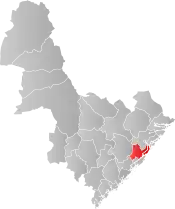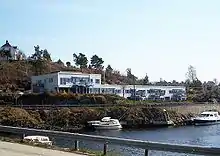Moland
Moland is a former municipality in the old Aust-Agder county in Norway. The 127-square-kilometre (49 sq mi) municipality existed from 1962 until 1992 when it was merged into the present-day municipality of Arendal which is located in what is now Agder county. The administrative centre of the municipality was the village of Eydehavn which had a population of 6,011 in 1967 and 8,148 in 1992. Other villages in the municipality included Kilsund, Narestø, Saltrød, Brekka, Strengereid, Vatnebu, and Sagene. The municipality consisted of the mainland area to the north and northeast of the town of Arendal plus the islands of Flostaøya and Tverrdalsøya.[1]
Moland kommune | |
|---|---|
 Aust-Agder within Norway | |
 Moland within Aust-Agder | |
| Coordinates: 58°32′52″N 08°48′40″E | |
| Country | Norway |
| County | Aust-Agder |
| District | Østre Agder |
| Established | 1 Jan 1962 |
| Disestablished | 1 Jan 1992 |
| Administrative centre | Eydehavn |
| Area | |
| • Total | 127 km2 (49 sq mi) |
| *Area at municipal dissolution. | |
| Population (1992) | |
| • Total | 8,148 |
| • Density | 64/km2 (170/sq mi) |
| Demonym(s) | Molending[2] |
| Time zone | UTC+01:00 (CET) |
| • Summer (DST) | UTC+02:00 (CEST) |
| ISO 3166 code | NO-0918 |
| Preceded by | Tvedestrand, Stokken, Austre Moland, and Flosta in 1962 |
| Succeeded by | Arendal in 1992 |
History

During the 1960s, there were many municipal mergers across Norway due to the work of the Schei Committee. The municipality of Moland was created on 1 January 1962 when a merger took place between the municipalities of Stokken (population: 2,783), Austre Moland (population: 1,607), and Flosta (population: 1,205) as well as Strengereid area (population: 375) of the municipality of Tvedestrand. On 1 January 1964, the Holte farm (population: 5) in Moland was transferred to Tvedestrand.
On 1 January 1992, another major municipality merger took place in this area. The municipalities of Moland (population: 8,148), Øyestad (population: 8,679), Tromøy (population: 4,711), and Hisøy (population: 4,026) were merged with the town of Arendal (population: 12,478) to form the new, much larger, municipality of Arendal with a population of nearly 40,000 people.[3]
Name
The municipality was named Moland, by dropping the word Austre (meaning "eastern") from the old name of one of its predecessor municipalities: Austre Moland. The name Moland comes from the Old Norse word Móðguland which is derived from the river name Móðga, which can be linked with the Old Norse word móðigr which means "brave".[4]
Coat of arms
The coat of arms was granted on 7 January 1983 and it was in use until the municipality's dissolution in 1992. The blue and white arms show a large, white letter "M" on a blue background. The colour represents the sea since the municipality has a long and rugged coastline, symbolized by the letter "M", the initial of the municipality. The three points in the "M" also refer to the three areas that formed Moland municipality: Stokken, Flosta, and Austre Moland.[5]
Government
All municipalities in Norway, including Moland, are responsible for primary education (through 10th grade), outpatient health services, senior citizen services, unemployment and other social services, zoning, economic development, and municipal roads. The municipality was governed by a municipal council of elected representatives, which in turn elected a mayor.[6]
Municipal council
The municipal council (Herredsstyre) of Moland was made up of representatives that were elected to four year terms. The party breakdown of the final municipal council was as follows:
| Party Name (in Norwegian) | Number of representatives | |
|---|---|---|
| Labour Party (Arbeiderpartiet) | 15 | |
| Progress Party (Fremskrittspartiet) | 3 | |
| Conservative Party (Høyre) | 6 | |
| Christian Democratic Party (Kristelig Folkeparti) | 3 | |
| Centre Party (Senterpartiet) | 1 | |
| Socialist Left Party (Sosialistisk Venstreparti) | 1 | |
| Liberal Party (Venstre) | 2 | |
| Total number of members: | 31 | |
| Party Name (in Norwegian) | Number of representatives | |
|---|---|---|
| Labour Party (Arbeiderpartiet) | 16 | |
| Progress Party (Fremskrittspartiet) | 2 | |
| Conservative Party (Høyre) | 7 | |
| Christian Democratic Party (Kristelig Folkeparti) | 4 | |
| Centre Party (Senterpartiet) | 1 | |
| Liberal Party (Venstre) | 1 | |
| Total number of members: | 31 | |
| Party Name (in Norwegian) | Number of representatives | |
|---|---|---|
| Labour Party (Arbeiderpartiet) | 14 | |
| Conservative Party (Høyre) | 9 | |
| Christian Democratic Party (Kristelig Folkeparti) | 5 | |
| Centre Party (Senterpartiet) | 1 | |
| Liberal Party (Venstre) | 2 | |
| Total number of members: | 31 | |
| Party Name (in Norwegian) | Number of representatives | |
|---|---|---|
| Labour Party (Arbeiderpartiet) | 16 | |
| Conservative Party (Høyre) | 6 | |
| Christian Democratic Party (Kristelig Folkeparti) | 5 | |
| New People's Party (Nye Folkepartiet) | 2 | |
| Centre Party (Senterpartiet) | 2 | |
| Total number of members: | 31 | |
| Party Name (in Norwegian) | Number of representatives | |
|---|---|---|
| Labour Party (Arbeiderpartiet) | 17 | |
| Conservative Party (Høyre) | 5 | |
| Christian Democratic Party (Kristelig Folkeparti) | 3 | |
| Centre Party (Senterpartiet) | 2 | |
| Liberal Party (Venstre) | 4 | |
| Total number of members: | 31 | |
| Party Name (in Norwegian) | Number of representatives | |
|---|---|---|
| Labour Party (Arbeiderpartiet) | 17 | |
| Conservative Party (Høyre) | 5 | |
| Christian Democratic Party (Kristelig Folkeparti) | 3 | |
| Centre Party (Senterpartiet) | 1 | |
| Liberal Party (Venstre) | 5 | |
| Total number of members: | 31 | |
| Party Name (in Norwegian) | Number of representatives | |
|---|---|---|
| Labour Party (Arbeiderpartiet) | 18 | |
| Conservative Party (Høyre) | 5 | |
| Christian Democratic Party (Kristelig Folkeparti) | 2 | |
| Centre Party (Senterpartiet) | 1 | |
| Liberal Party (Venstre) | 5 | |
| Total number of members: | 31 | |
Notable residents
- Tore A. Liltved, a local politician
- Thor Lund, a local politician and mechanic
References
- Thorsnæs, Geir, ed. (14 January 2016). "Moland". Store norske leksikon (in Norwegian). Kunnskapsforlaget. Retrieved 27 November 2017.
- "Navn på steder og personer: Innbyggjarnamn" (in Norwegian). Språkrådet.
- Jukvam, Dag (1999). "Historisk oversikt over endringer i kommune- og fylkesinndelingen" (PDF) (in Norwegian). Statistisk sentralbyrå.
- Rygh, Oluf (1905). Norske gaardnavne: Nedenes amt (in Norwegian) (8 ed.). Kristiania, Norge: W. C. Fabritius & sønners bogtrikkeri. p. 87.
- "Civic heraldry of Norway - Norske Kommunevåpen". Heraldry of the World. Retrieved 28 November 2017.
- Hansen, Tore, ed. (12 May 2016). "kommunestyre". Store norske leksikon (in Norwegian). Kunnskapsforlaget. Retrieved 21 December 2020.
- "Kommunestyrevalget 1987" (PDF) (in Norwegian). Oslo-Kongsvinger: Statistisk sentralbyrå. 1988. Retrieved 21 December 2020.
- "Kommunestyrevalget 1983" (PDF) (in Norwegian). Oslo-Kongsvinger: Statistisk sentralbyrå. 1984. Retrieved 21 December 2020.
- "Kommunestyrevalget 1979" (PDF) (in Norwegian). Oslo: Statistisk sentralbyrå. 1979. Retrieved 21 December 2020.
- "Kommunevalgene 1975" (PDF) (in Norwegian). Oslo: Statistisk sentralbyrå. 1977. Retrieved 21 December 2020.
- "Kommunevalgene 1972" (PDF) (in Norwegian). Oslo: Statistisk sentralbyrå. 1973. Retrieved 21 December 2020.
- "Kommunevalgene 1967" (PDF) (in Norwegian). Oslo: Statistisk sentralbyrå. 1967. Retrieved 21 December 2020.
- "Kommunevalgene 1963" (PDF) (in Norwegian). Oslo: Statistisk sentralbyrå. 1964. Retrieved 21 December 2020.


